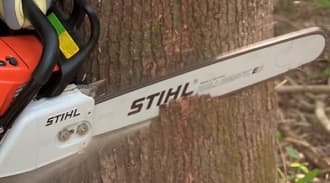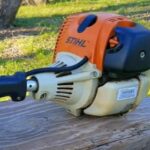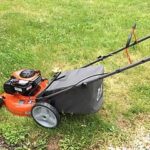As an Amazon Associate, this site earns commissions from qualifying purchases. For more information click here.
You have been working for several hours and suddenly your chainsaw stops. You take a look at the fuel tank and it is empty. No problem right? You fill it up again but the engine refuses to start. This can be a cause for concern, but there are ways you can fix this.
If your chainsaw won’t start after running out of gas, check the spark plug. It might be damaged or dirty. The chainsaw intake filter might also be covered in dirt and require cleaning or replacement.
Never let a 2-stroke chainsaw run out of gas. That is the easiest solution to this problem. You have often heard people say never let gas sit more than 30 days in a chainsaw engine. That is true. But you should never let the tank go empty when you are using it.
This advice is well and good, but what if it did happen? What if your chainsaw won’t start after running out of gas? In that case the following information can help you.
Check the Spark Plug
The spark plug makes engine fuel combustion possible. If it is dirty or damaged, your chainsaw will not start. Even if you refuel the engine will not start until the spark plug issue is fixed.
Solution. Clean or replace the spark plug.
- Turn the chainsaw off and look for the plug. Refer to your user manual.
- Remove the spark plug. If it is covered with carbon deposit, clean or replace it.
- If the electrodes are damaged a replacement is needed. You can use a spark plug tester to verify this. Unless the plug is brand new, it is better to get a new one. When buying another plug, it has to be an exact match to the one it is replacing.
If the spark plug is dirty and not damaged, clean it with a wire brush. Refuel the chainsaw and start it again. If that does not work, buy a new plug.
When installing a spark plug, the gap has to be correct. You can use a spark plug gap tool to get a precise measurement.
Before installing a new (or newly cleaned) plug, look for oil leak signs. If the plug is covered with oil, there might be a problem with the carburetor or fuel line. Find the source of the leak first.
The Air Filter is Dirty
The air filter on your chainsaw keeps dirt and debris away from the engine. This filter eventually gets covered up with dirt. If the chainsaw is out of gas, the engine could end up absorbing dirt instead. When new gas is added, it gets contaminated by dirt. This prevents the chainsaw from running.
Solution. Clean the air filter regularly.
Clean the air filter after every 10 hours of usage. Replace it at least every 6 months. This is for chainsaws that are used regularly. If yours is utilized heavily in harsh environments, more frequent cleaning or replacing is needed. So if your Craftsman S165 42CC gets a good workout, clean the filter often..
To clean or replace a chainsaw air filter:
- Turn the chainsaw. Lift the air filter cover. In some chainsaws the cover is held by screws.
- You will see the filter. Air filters are either made of paper or foam. Most are foam because paper is not reusable. If it is a paper filter, you have to buy a new one. If it is foam, you can clean and reuse it.
- If the foam filter is covered with light dirt, use a wire brush. If that is not enough, dip the filter in warm water mixed with liquid soap. Wait for the filter to dry before putting it back on the chainsaw.
- Refuel the tank and turn the chainsaw on.
This is one of the benefits of a reciprocating saw over a chainsaw, needing less maintenance. Chainsaws are more powerful however. There are also other factors to consider if you are choosing between a chainsaw and a reciprocating saw.
Old Fuel Clogging
If you left fuel for more than 30 days in the tank, it will turn into thick goo. This will clog up the tank. When you run the chainsaw, the goo spreads on the spark plug, filter, carburetor and other engine parts.
Eventually what is left of the usable gas is used by the chainsaw. When you refuel however, the goo clogs the engine and prevents the fuel from igniting. No matter how much fuel you add, the chainsaw will not run.
Solution. Clean the fuel tank. Drain the fuel, if there is any left. Clean the oil residue with soap and water. Repeat as often as necessary to remove the sludge. You should only add new gas when the tank is thoroughly cleaned.

Broken Pulley Mechanism
Chainsaw starter cords have to be pulled 6-8 times. If yours is an old model or worn out, it might take more. If you cleaned the tank and refueled, the chainsaw pulley might just need a few pulls to catch on.
It is also possible that the pulley mechanism has been damaged. It is possible to fix this but in most instances this will require a replacement.
Note that a broken pulley is rarely the reason why a chainsaw won’t start after refueling. You should only consider this option if the rest have been exhausted.
Wrong Fuel Mixture
Chainsaws are mostly on 2-stroke engines, which require a mixture of oil and gas. The common ratio is 50:1 for oil and gas. But other chainsaws use a 40:1 or 32:1 ratio. If you make a mistake, the chainsaw will not start.
Two-stroke engines do not like running out of gas and wrong fuel ratios. Anyone who has used a 2-stroke engine will tell you that you must never let it run out of gas. Even if you fill it up, there could be issues.
The other potential problem is using the wrong ratio. If you accidentally added a 40:1 mix instead of 50:1, the engine might stall. If you only poured in gas the chainsaw will not run at all.
Add Fuel Stabilizer
A fuel stabilizer does exactly that, stabilize the fuel. It is usually added when a chainsaw is about to be stored for long periods of inactivity (winter for example). If you do not want to empty the tank, add fuel stabilizer to prevent the oil from turning into sludge.
If you left old fuel in the tank clean it first. Do not add new fuel yet because the sludge will clog it. Clean the fuel tank, spark plug, carburetor and the rest of the engine. Only then should you refuel. Remember to follow the instructions on your fuel stabilizer about how much to add.
If you add Seafoam or a similar product, you can keep the tank filled up all the time. Just turn it on once every two to three months and it should be fine. The alternative of course is to just drain the fuel before storing it for winter.
Clean the Carburetor
The carburetor is where fuel and air are mixed. A dirty carburetor will not function and make it impossible for the chainsaw to work. This video shows you how a chainsaw carburetor is cleaned.
To clean the carburetor, lift the lid cover. You might have to remove some screws here. Next, apply a carburetor cleaning solution. Let it dry before putting it back.
When the carburetor is cleaned, put new gas in. Prime the engine and let it run for a few minutes. If it does not stall, you can start using the chainsaw. If it stalls, check if the spark plug is damaged. If the plug, fuel filter, air filter and fuel lines are fine, the carburetor might need to be replaced.
If you do not want to replace the carburetor, you can rebuild it. But this option is not for everyone. If you are not familiar with the process, it is safer to replace the carburetor. Before you do so, check your chainsaw manufacturer website for the exact carburetor type needed.

I love the outdoors and all the tools for maintaining gardens, yards and lawns. The only thing I am more passionate about is sharing what I know about garden and outdoor equipment.


